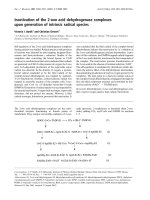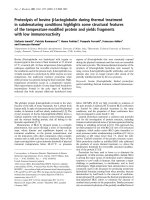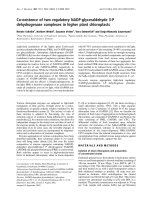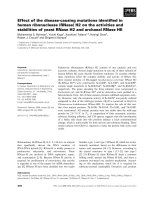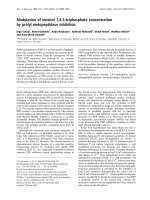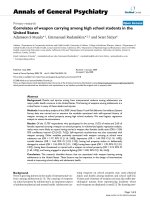Báo cáo Y học: Co-existence of two regulatory NADP-glyceraldehyde 3-P dehydrogenase complexes in higher plant chloroplasts ppt
Bạn đang xem bản rút gọn của tài liệu. Xem và tải ngay bản đầy đủ của tài liệu tại đây (460.99 KB, 8 trang )
Co-existence of two regulatory NADP-glyceraldehyde 3-P
dehydrogenase complexes in higher plant chloroplasts
Renate Scheibe
1
, Norbert Wedel
2
, Susanne Vetter
1
, Vera Emmerlich
3
and Sonja-Manuela Sauermann
1
1
Plant Physiology, University of Osnabrueck, Germany;
2
Planton GmbH, Kiel, Germany;
3
Plant Physiology, University of
Kaiserslautern, Kaiserslautern, Germany
Light/dark modulation of the higher plant Calvin-cycle
enzymes phosphoribulokinase (PRK) and NADP-depend-
ent glyceraldehyde 3-phosphate dehydrogenase (NADP-
GAPDH-A
2
B
2
) involves changes of their aggregation state
in addition to redox changes of regulatory cysteines. Here we
demonstrate that plants possess two different complexes
containing the inactive forms (a) of NADP-GAPDH and
PRK and (b) of only NADP-GAPDH, respectively, in
darkened chloroplasts. While the 550-kDa PRK/GAPDH/
CP12 complex is dissociated and activated upon reduction
alone, activation and dissociation of the 600-kDa A
8
B
8
complex of NADP-GAPDH requires incubation with
dithiothreitol and the effector 1,3-bisphosphoglycerate. In
the light, PRK is therefore completely in its activated state
under all conditions, even in low light, while GAPDH acti-
vation in the light is characterized by a two-step mechanism
with 60–70% activation under most conditions in the light,
and the activation of the remaining 30–40% occurring only
when 1,3-bisphosphoglycerate levels are strongly increasing.
In vitro studies with the purified components and coprecipi-
tation experiments from fresh stroma using polyclonal
antisera confirm the existence of these two aggregates. Iso-
lated oxidized PRK alone does not reaggregate after it has
been purified in its reduced form; only in the presence of
both CP12 and purified NADP-GAPDH, some of the PRK
reaggregates. Recombinant GapA/GapB constructs form
the A
8
B
8
complex immediately upon expression in E. coli.
Keywords: enzyme aggregation; light/dark regulation;
NADP-glyceraldehyde 3-P dehydrogenase; phospho-
ribulokinase; spinach chloroplast.
Various chloroplast enzymes are subjected to light/dark
modulation of their activity, brought about by a redox-
modification at specific cysteine residues mediated by the
ferredoxin/thioredoxin system [1]. The activity of each of
these enzymes is adjusted by fine-tuning, the rates of
reduction and/or of oxidation being influenced by specific
metabolites [2]. At constant redox conditions, this allows for
independent changes in the steady-state activities of each of
the enzymes merely by changes in the metabolic state of the
chloroplast [3,4]. In some cases, the reversible changes of
redox and activation states are accompanied by oligomeri-
zation and re-dissociation of transient complexes.
Enzyme aggregations of various compositions have been
described repeatedly, their occurrence under in vivo condi-
tions still being under debate [5,6]. But even the actual
composition of enzyme aggregates containing NAD(P)-
dependent glyceraldehyde-3 P dehydrogenase [NAD(P)-
GAPDH] and phosphoribulokinase (PRK) is controversial.
Both activities appear to occur in high-molecular-mass
forms in darkened chloroplasts, either in homo-oligomers
[7–10] or in hetero-oligomers [11,12], the latter involving a
small chloroplast protein, CP12, with a high sequence
similarity to the C-terminus of subunit B of the unique
chloroplast form of GAPDH [13]. Here we describe the
presence of both types of aggregations in darkened spinach
chloroplasts, one consisting of GAPDH A and B alone, the
other consisting of PRK, GAPDH, and CP12. The
differential stability of both complexes upon reductive
activation, the formation of the A
8
B
8
-GAPDH complex
from the recombinant subunits in Escherichia coli,the
reconstitution of the hetero-oligomeric PRK/GAPDH/
CP12 complex from the isolated components in vitro,and
coprecipitation from oxidized stroma using antisera against
the individual components, support this fact.
MATERIALS AND METHODS
Isolation of intact chloroplasts and preparation
of concentrated stroma
Darkened spinach leaves from plants in hydroponic culture
were cut and homogenized in isotonic medium consisting of
330 m
M
mannitol, 30 m
M
Mops, 2 m
M
EDTA, pH 7.8,
according to [14]. The chloroplast pellet was washed twice
and then treated on ice with a glass homogenizer using as
little additional medium as possible. All steps were per-
formed in darkness. After centrifugation, the cleared
supernatant was filtered through a 0.2-lm filter. The protein
content was determined according to [15] with BSA as a
standard. The protein concentration was adjusted to 10 mg
per 2 mL sample with column buffer (see gel filtration)
Correspondence to R. Scheibe, Plant Physiology, University of
Osnabrueck, Osnabrueck D-49069, Germany.
Abbreviations: GapA/GapB, subunits A and B of GAPDH; GAPDH,
glyceraldehyde 3-P dehydrogenase; GSH and GSSG, reduced and
oxidized glutathione; PRK, phosphoribulokinase.
Enzymes: NAD(P)-dependent glyceraldehyde 3-phosphate
dehydrogenase (EC 1.2.1.13); phosphoribulokinase (EC 2.7.1.19).
(Received 3 June 2002, revised 21 August 2002,
accepted 18 September 2002)
Eur. J. Biochem. 269, 5617–5624 (2002) Ó FEBS 2002 doi:10.1046/j.1432-1033.2002.03269.x
either without (dark) or with 20 m
M
dithiothreitol, and
incubated in a darkened vial for 30 min at 25 °C. For light-
activation experiments, intact chloroplasts were isolated and
incubated in bicarbonate-containing medium as described
in [9].
Gel filtration on Superdex S-200
Preincubated samples were filtered through a calibrated
Superdex 200 column (Hiload 16/60) (Pharmacia, Freiburg,
Germany) at 1 mLÆmin
)1
, collecting fractions of 1 mL
which were used for enzyme assays. The column buffer
consisted of 10 m
M
bicine/KOH, 150 m
M
NaCl, 140 l
M
NAD, pH 7.8, for ÔdarkÕ samples, and additionally 2.5 m
M
dithiothreitol for ÔdithiothreitolÕ samples.
Enzyme assays
Aliquot samples of the fractions were either assayed directly
or after preincubation with 50 m
M
dithiothreitol (for PRK
activation) or with 20 m
M
dithiothreitol and 21 l
M
1,3-
bisphosphoglycerate in a regenerating system as in [16] for
GAPDH activation. The 1,3-bisphosphoglycerate-system as
fivefold stock solution contained 100 m
M
Tris/HCl, pH 7.8,
8m
M
MgSO
4
,1m
M
EDTA, 4 m
M
ATP, 9 m
M
3-PGA and
PGK (3.6 UÆmL
)1
). The PRK assay was as in [17]. NADP-
dependent GAPDH activity was determined as in [16].
Protein purification
PRK was purified from spinach leaves according to [18]
with some modifications. During all purification steps
10 m
M
dithiothreitol was present. The proteins precipitating
between 40 and 55% of the saturation of ammonium sulfate
at 4 °C were resuspended and subjected to acid precipitation
with acetic acid at pH 5.0. The supernatant was adjusted to
pH 6.8 and dialyzed over night. The diluted and clarified
solution in 10 m
M
bicine/KOH, 10 m
M
dithiothreitol,
pH 6.8, was subjected to affinity chromatography on
Reactive Red (Merck, Darmstadt, Germany), washed with
the same buffer. After a washing step with 10 m
M
potassium
phosphate, 10 m
M
dithiothreitol, pH 6.9, the PRK was
eluted in 10 m
M
potassium phosphate, pH 7.2, 10 m
M
dithiothreitol, and 5 m
M
ATP. The fractions with PRK
activity were concentrated by ammonium sulfate precipita-
tion (80% of saturation) and resuspended in 50 m
M
bicine/
KOH, 10 m
M
potassium phosphate, 1 m
M
EDTA, 10 m
M
dithiothreitol, 10% glycerol, pH 8.0, and subjected to gel
filtration in 100 m
M
bicine/KOH, 10 m
M
dithiothreitol,
1m
M
EDTA, pH 8.0. Storage of the active dimeric protein
was in 50% glycerol at )20 °C.
GADPH was purified from spinach leaves as described
by [19], slightly modified as in [16]. GapA and GapB were
expressed as a combined construct in E. coli BL21DE3
pLys S containing the two clones each unter the control of
the T7 promoter, and the kanamycin and the ampicillin
resistance gene, respectively, in order to control the presence
of both constructs.
CP12 from spinach was produced in E. coli with an
N-terminal His-tag and was purified using Ni-chelating
chromatography. Elution was achieved with 1
M
imidazol,
0.5
M
NaCl in 20 m
M
Tris/HCl, pH 7.9. For reconstitution
experiments the His-tag was removed by proteolysis using
thrombin according to the manufacturer’s protocol (Strate-
gene, Heidelberg, Germany). The CP12 clone for the
mature protein was originally described in [13].
Artificial stroma conditions
Reconstitution experiments with the purified proteins were
performed in a solution simulating the high protein
conditions in the stromal sample using a modified Ôartificial
stromaÕ [20]. In more detail, the sample for dark conditions
consisted of 5 m
M
MgSO
4
,10m
M
NaCl, 5 m
M
KNO
3
,
5m
M
KH
2
PO
4
,25m
M
sucrose, 20 m
M
glucose, 5 m
M
fructose, 40 l
M
NAD, 20 m
M
GSSG, the purified proteins
(each about 200 lg) and BSA (defatted) to reach a total
protein content of 10 mg per 2 mL sample. Incubation was
30 min at room temperature and then at 4 °Covernight.
The purified GAPDH was pretreated with 100 l
M
1,3-
bisphosphoglycerate in a regenerating system and desalted
in order to obtain the oxidized A
2
B
2
form prior to the
reconstitution assay.
SDS/PAGE, Western blotting and immunodecoration
Equal volumes of fractions after gel filtration were subjected
to SDS/PAGE (12% acrylamide), and the gels were
electroblotted and immunodecorated as in [12].
Immunoprecipitation
Protein-A Sepharose was preincubated with either preim-
mune serum or the indicated antisera in Tris-buffered saline
for 30 min at room temperature, washed once and then
addedtostromalextractsthathadbeenpreincubatedwith
140 l
M
NAD and 20 m
M
GSSG. After incubation for
30 min, the supernatant was used to assay for GAPDH and
PRK activities after full activation. The antisera against
CP12 and NADP-GAPDH have been obtained from
rabbits using the spinach proteins purified from E. coli
and spinach, respectively. Antiserum against PRK was a
kind gift from Fred Hartman, Oak Ridge, USA.
RESULTS
Reversible aggregation of GAPDH and PRK
in chloroplasts
When the soluble fraction of isolated darkened spinach
chloroplasts was subjected to gel filtration, both GAPDH
and PRK were obtained as high-molecular-mass aggregates
(Fig. 1A). Enzyme activities in the fractions were detected
after full activation. The activity peaks do not coincide
completely, GAPDH eluting somewhat earlier than PRK in
all cases. This tendency was even more pronounced in maize
chloroplasts (Fig. 2), where the GAPDH activity formed a
distinct shoulder at 600 kDa in addition to the peak at
550 kDa that coincided with the PRK activity. The high-
molecular-mass form of GAPDH is almost inactive due to
its decreased affinity for 1,3-bisphosphoglycerate [16]. PRK
in darkened chloroplasts when eluted as the 550-kDa form
is also inactive; its activity is only retrieved upon preincu-
bation of the fractions with dithiothreitol (Fig. 3A). On the
other hand, the dimeric PRK as obtained from illumin-
ated chloroplasts is eluted as fully active enzyme (Fig. 3B).
5618 R. Scheibe et al. (Eur. J. Biochem. 269) Ó FEBS 2002
PRK purified in its reduced dimeric state [18] can be
reversibly inactivated by treatment with oxidant [21], but
remains dimeric (Fig. 3C).
Preincubation of spinach chloroplasts with 20 m
M
dithio-
threitol for 30 min resulted in the complete disappearance
of high-molecular-mass PRK and in the partial ( 50%)
dissociation of the GAPDH aggregates (Fig. 1B). From
experiments with the purified enzyme it is known that
reductive treatment of the 600-kDa A
8
B
8
-GAPDH form
does not lead to any increase in activity nor to dissociation
[16]. From the two-peak elution pattern of the GAPDH
activity, we therefore assumed the presence of two types of
GAPDH-containing aggregates, namely the A
8
B
8
complex
which was still intact after incubation with dithiothreitol
alone [16], and the GADPH/PRK/CP12 complex described
by [12] which, upon reduction, releases GAPDH and PRK
as tetramer and dimer, respectively. CP12 and PRK could
not be detected by the respective antisera in the high-
molecular-mass fractions after dithiothreitol treatment,
while all three proteins were detectable with antisera in the
peak fractions of the untreated sample (Fig. 1C,D). The
high-molecular-mass fraction did not contain other enzyme
activities such as phosphoglycerate kinase [22] or fructose
1,6-bisphosphatase [23] that had been suggested to also
form high-molecular-mass aggregates (data not shown).
Furthermore, we never detected any tetramic GAPDH in
dark stroma which has been suggested to occur as A
4
by
[24].
Differential activation behaviour for GAPDH and PRK
upon dithiothreitol and light treatment
Incubation of chloroplast stroma with increasing concen-
trations of dithiothreitol resulted in 100% activation of
PRK even at low dithiothreitol concentrations at pH 8.0
(Fig.4A).Incontrast,evenupto20m
M
resulted in only
60–70% for the maximal GAPDH activity. Only in the
presence of added ATP and/or 3-phosphoglycerate, thus
increasing the 1,3-bisphosphoglycerate concentration in the
stroma [9], 100% activation of GAPDH was reached. This
is true also for activation by light, where 100% of PRK and
40–60% of GAPDH activity were reached already at very
low light intensities. These levels were unchanged over a
wide range of light intensities, only addition of ATP to the
isolated chloroplasts increased the level of GAPDH activa-
tion to 100% (Fig. 4B). This is in agreement with the
fact that both reduction and 1,3-bisphosphoglycerate are
required for activation and dissociation of GAPDH from
the A
8
B
8
form [9,16].
Reaggregation of PRK and GAPDH from chloroplast
fractions
Purification of PRK according to published procedures
[3,17] is always performed in the presence of dithiothreitol,
leading to the preparation of the enzyme in its reduced
active form. Using this enzyme, the mechanism of reversible
Fig. 1. Gel filtration of spinach chloroplast
stroma from darkened leaves. The extract was
preincubated either in the absence (A, C) or in
thepresenceof10m
M
dithiothreitol (DTT)
(B,D)for30minat25°C. The activities of
PRK (s) and of NADP-GAPDH (d)were
determined in aliquot fractions after full
activation as described under Materials and
methods. Every second fraction was subjected
to SDS/PAGE. The gel was stained with
Poinceau Red (0.2% in 3% (w/v) trichloro-
acetic acid), destained, and immunodecorated
with the indicated antisera (C,D). Fractions
reacting with the antiserum against CP12 are
highlightedwithanarrow.
Fig. 2. Gel filtration of chloroplast stroma from darkened maize leaves
in the absence of dithiothreitol. PRK (s) and NADP-GAPDH (d)
activities were determined after full activation as described in Materials
and methods.
Ó FEBS 2002 Two regulatory GAPDH complexes in chloroplasts (Eur. J. Biochem. 269) 5619
redox-modification mediated by thioredoxin has been
analyzed in much detail. The redox-active Cys residues
have been identified (Cys15 and Cys55) [25], their redox
potential has been determined [3,26], and the interaction
with thioredoxin f has been studied [21].
In order to analyze the structural changes upon redox
modification, we have reoxidized the purified, reduced
enzyme. Incubation with 50 m
M
dithiothreitol
ox
or with
25 m
M
GSSG at pH 8.0 resulted in an almost complete
inactivation. This inactivation could be reversed by the
addition of reductant (Table 1). However, both the reduced
and the oxidized enzyme forms appeared as dimers upon gel
filtration (Table 1) (Fig. 3C). This is in contrast to the
experiments with chloroplast stroma, where the oxidized
Fig. 3. Gel filtration of spinach chloroplast stroma obtained from
darkened (A) or from illuminated (B) organelles. The PRK activity in
the fractions was either determined directly (s) or after full activation
(d). In (C), purified enzyme either in its original reduced state (d)or
after oxidation with GSSG (s) was subjected to gel filtration.
Fig. 4. Activities of PRK and NADP-GAPDH: (A) dependence upon
dithiothreitol concentration in a stromal extract and (B) dependence on
light intensity in intact chloroplasts. (A) The stromal extract was pre-
incubated with the given concentrations of dithiothreitol for 30 min at
25 °C(d,s). A parallel sample was incubated with dithiothreitol
(DTT) at the various concentrations and 21 l
M
1,3-bisphosphogly-
cerate-regenerating system (m). The samples were assayed for PRK
(s) and NADP-GAPDH activity (d,m). (B) The intact chloroplasts
were incubated in the presence of 5 m
M
sodium bicarbonate (d,s)and
in addition 0.5 m
M
3-phosphoglycerate and 0.25 m
M
ATP (m).
Table 1. Activity and aggregation state of purified spinach PRK.
Reduced PRK was purified in the presence of 10 m
M
dithiothreitol.
Oxidized PRK was treated with 25 m
M
GSSG or with 50 m
M
oxidized
dithiothreitol, pH 8.0, for 15 min at 20 °C.
Reduced Oxidized
Activity (UÆmg protein
)1
) 437 8
Molecular mass (kDa) 80 80
5620 R. Scheibe et al. (Eur. J. Biochem. 269) Ó FEBS 2002
dark form of PRK appears as high-molecular-mass form.
Such controversial behaviour has been described already
[8,21].
In order to investigate the requirement for a small stromal
protein (i.e. CP12) for reaggregation of dimeric PRK, we
separated the dissociated enzyme (Fraction II: 80–120 kDa
in Fig. 5A) from the higher-molecular-mass fraction at
600 kDa (Fraction I) by gel filtration. Then a concentrated
fraction containing the smaller stromal proteins (Fraction
III: 20–60 kDa) and the enzyme fraction II were incubated
together with GSSG. After another step of gel filtration, a
new high-molecular-mass fraction became apparent con-
taining PRK activity (after reductive activation of the
fractions) (Fig. 5B). This peak contained almost equal
activities of GAPDH and PRK.
Reconstitution of GAPDH (A
8
B
8
) and PRK/GAPDH/CP12
complexes
In a further approach, we attempted to reconstitute both
complexes from the purified components. For these experi-
ments, the purified proteins were kept in an artificial stroma
according to [20] containing various ions, sugars, and amino
acids (see Materials and methods) and in addition 140 l
M
NAD, 10 m
M
GSSG and BSA (20 mgÆmL
)1
)inorderto
simulate the conditions of high protein concentration in the
chloroplast stroma. Under these conditions, absolutely no
aggregation was observed with PRK and CP12 alone
(Fig. 6A). In contrast, incubation of PRK with purified
GAPDH and CP12 resulted in the aggregation of some of
Fig. 5. Gel filtration of spinach chloroplast stroma in the presence of
dithiothreitol and reaggregation of the components of the GAPDH/
PRK/CP12 complex. After gel filtration on Superdex 200 of dithio-
threitol-treated stroma, the combined fractions II and III as indicated
in (A) were concentrated and incubated over night. (B) After another
passage through Superdex 200, the fractions were assayed for PRK (s)
and NADP-GAPDH (d) activity after full activation.
Fig. 6. Reconstitution of PRK/GAPDH/CP12 and GAPDH (A
8
B
8
)
complex from the purified/recombinant components. (A, B) The purified
proteins were incubated in Ôartificial stromaÕ as described under
Materials and methods. GAPDH (400 lg) pretreated with 380 l
M
1,3-bisphosphoglycerate and desalted in order to generate the tetra-
meric A
2
B
2
form, was present in addition to 200 lg purified PRK and
200 lg recombinant CP12. (C) Recombinant GAPDH consisting of
the subunits A and B in the soluble extract from IPTG-induced E. coli
cells was directly applied to a Superdex-200 gel filtration column. All
proteins were kept in their oxidized form by incubation with 20 m
M
GSSG.
Ó FEBS 2002 Two regulatory GAPDH complexes in chloroplasts (Eur. J. Biochem. 269) 5621
the PRK and all of the GAPDH (Fig. 6B). The low yield of
PRK reaggregation was probably due to the rather artificial
conditions. Some of the aggregated GAPDH was most
likely in its A
8
B
8
form.
Finally, the expression of both GAPDH subunits in
E. coli was performed. A high-molecular-mass complex
formed immediately in E. coli upon expression of the
combined construct for GapA and GapB and eluted as a
600-kDa form (Fig. 6C). The activation characteristics of
the recombinant GAPDH are typical for the A
8
B
8
form,
which is still present in the 600-kDa peak in dithiothreitol-
treated stroma (fraction I). In both cases, activation was
obtained only after incubation with both dithiothreitol and
1,3-bisphosphoglycerate, not with dithiothreitol alone
(Fig. 7).
Immunoprecipitation
Using the specific antisera against the components of the
two complexes, namely GAPDH, PRK and CP12, GSSG-
oxidized stromal extracts were fractionated. In order not to
disturb the existing complexes, the immunoglobulin fraction
was bound to immobilized Protein A and washed with
50 m
M
bicine/KOH, pH 8.0, before it was exposed to
oxidized stroma containing 140 l
M
NAD which stabilizes
the complexes and also the enzyme activities. The enzyme
composition in the supernatant was quantified from the
activities obtained after complete activation. The results are
shown in Table 2. With antiserum against NADP-GAPDH
about 82.5% of the PRK activity could be coprecipitated
with 91.5% of the GAPDH activity, indicating that only
17.5% of the PRK was not associated with GAPDH in a
complex. On the other hand, the antiserum against PRK
removed only 42.9% of the GAPDH from the solution,
together with 96.1% of the PRK. This again indicates the
presence of an independent GAPDH-A
8
B
8
complex apart
from the PRK/GAPDH/CP12-mixed complex. The fact
that the antiserum raised against recombinant CP12 only
removed a small proportion of the enzymes from the
solution, is most likely due to inaccessibility of the CP12 in
the native complex, because the serum recognized native
soluble CP12 in reduced stromal extracts (data not shown).
DISCUSSION
In general, evidence is increasing that cellular contents are
well organized in microcompartments due to protein–
protein interactions between partners of a metabolic path-
way or of a signal transduction cascade. In particular for
chloroplasts, there have been various attempts to show the
presence of bi- or multi-enzyme complexes of Calvin-cycle
enzymes (reviewed in [27]); however, there are intrinsic
technical problems when trying to confirm any of the
interactions unambiguously. The critical step is always
the breakage of the cell or the organelle, since changes of
the protein concentration and of the low-molecular-mass
components of the soluble medium will occur.
In order to avoid any new formation of complexes,
ammonium sulfate precipitation has been omitted in our
procedure and stromal fractions were applied directly to the
gel filtration column. This leads to reproducable elution
profiles on the Superdex 200 column in the presence of
150 m
M
NaCl, with two distinguishable peaks at 600 and
550 kDa eluting well after the void volume. It should be
pointed out, however, that the protein concentration of the
stroma sample for gel filtration is critical to obtain the
described results [28].
Rubisco is eluted at the same position as PRK (550 kDa),
but the subunit composition (L
8
S
8
) of the former suggests
that further enzymes are not associated in the same
complex, although this assumption is in contrast to the
results of Rault et al. [6] who purified a five-enzyme
complex of 540 kDa containing Rubisco, GAPDH, PRK,
phosphoriboseisomerase, and 3-phosphoglycerate kinase.
Other activities, such as FBPase that had been described to
be subject to aggregation [23] or had been seen as part of the
so-called photosynthetosome [5] could not be detected in
this range. It cannot be excluded, however, that weaker
interactions are involved in such supramolecular organiza-
tion observed by other groups that are therefore not stable
under the conditions applied in this study.
Previously we had identified and characterized the A
8
B
8
-
GAPDH form present in darkened chloroplasts [9,16].
Later, we showed by limited proteolysis [29] and using
truncated constructs expressed in E. coli [30] that the unique
C-terminal sequence extension of GapB is responsible for
Fig. 7. Activation properties of A
8
B
8
-GAPDH in stromal extract and in
E. coli. GAPDH activites in the 600-kDa peak fractions of dithio-
threitol-treated stroma and of the recombinant GapA/GapB prepar-
ation were determined. The pooled fractions of peak I from Fig. 5A
(grey bars) and from Fig. 6C (hatched bars) were either assayed
directly. (– DTT), after incubation with 10 m
M
dithiothreitol
(+ DTT), or with 10 m
M
dithiothreitol and 21 lg 1,3-bisphospho-
glycerate (+ DTT/1,3bisPGA). DTT, dithiothreitol.
Table 2. Percentage coprecipitation of PRK-, GAPDH- and CP12-
containing complexes from oxidized stroma. The activities remaining in
the supernatant were determined after full activation.
Antiserum NADP-GAPDH PRK
Preimmune 100 100
Anti-GAPDH 8.5 17.5
Anti-PRK 57.1 3.9
5622 R. Scheibe et al. (Eur. J. Biochem. 269) Ó FEBS 2002
aggregation and inactivation of GAPDH in the dark.
Likewise, expression of the complete subunit B in E. coli
had led to aggregated forms [30,31]. Dissociation and
activation of the A
8
B
8
complex requires 1,3-bisphosphogly-
cerate [9,16,32].
Analyzing PRK activation, there was an obvious dis-
crepancy between in vitro results with the purified enzyme
and results obtained after gel filtration of chloroplast
stroma, a fact also observed by [21]. Therefore, it was
assumed that PRK had lost a component enabling aggre-
gation in vivo, and re-addition of a low-molecular-mass
stromal fraction to the fraction of dissociated enzymes
indeed allowed reaggregation (see Fig. 5).
In this paper, we have attempted to characterize such a
PRK-containing complex, having in mind the postulated
existence of a mixed GAPDH–PRK complex containing
CP12 as described previously [33]. Therefore it was neces-
sary to separate the A
8
B
8
form of GAPDH and such mixed
complex. This could be achieved by various means due to
their diverging properties upon activation and dissociation.
In addition, reconstitution and coprecipitation experiments
using specific antisera helped to confirm the presence of two
different complexes. Unfortunately, the anti-CP12 serum
was not able to reach this protein when part of the complex
due to sterical hindrance. Taken together, it could be
established that GAPDH activity is present in two different
complexes reacting with distinct sensibility towards dithio-
threitol and the effector 1,3-bisphosphoglycerate leading to
dissociation and activation. On the other hand, all PRK
activity was present in a mixed complex forming only in the
presence of both GAPDH and CP12.
In order to understand the differential regulation of
Calvin-cycle enzymes, their midpoint redox potentials have
been determined and compared to physiological data
obtained with the intact system [34]. The apparent discrep-
ancies with respect to GAPDH could be easily explained
with the presence of two differently responding GAPDH-
containing aggregates: (a) the early evolved system, namely
PRK/GAPDH/CP12, which is activated merely by reduc-
tion and is already present in cyanobacteria [33]; and (b) the
A
8
B
8
form that evolved with the appearance of multicellular
green organisms when GapB emerged in Characeae for the
first time (R. Cerff and J. Peterson, Institut fu
¨
r Genetik, Tu
Braunschweig, Germany, personal communication).
The occurrence of both aggregates in plants indicates their
special role for optimal photosynthesis under all conditions.
A fast-responding system for complete PRK activation and
activation of a portion of GAPDH is required for CO
2
assimilation under rather constant conditions, and is thus
available in all photosynthetic organisms. Green plants with
less constant environments (evolution of land plants)
acquired in addition a larger fraction of GAPDH activity
that, however, remains latent until a certain level of the
substrate 1,3-bisphosphoglycerate indicates the demand to
increase the flux specifically at this point. For the situation in
higher plants this means that there is a two-level activation of
GAPDH, reaching 50–60% of the total activity even under
low light and low reductant concentrations and 100%
activation only with at increased 1,3-bisphosphoglycerate
levels. Full activation of PRK is achieved under all
conditions (see Fig. 4). Calculating the stoichiometry of
the enzyme subunits engaged in the two complexes using the
specific activities of the purified enzymes (GAPDH 200,
PRK 400 UÆmg protein
)1
) and the activities present in the
stroma (700 and 300 lmolÆmg Chl
)1
Æh
)1
). The ratio of 2
GAPDH/PRK/CP12 complexes to 1 A
8
B
8
complex sup-
ports the finding of a ratio of 1 : 1 of the total GAPDH
activity in both complexes.
From our experience, even very dim light during chloro-
plast isolation or preparation of extract leads to a significant
level of PRK activity and to some basic GAPDH activity
that is often described as Ôdark activityÕ. In contrast, strict
darkness during these steps will result in complete inactiva-
tion. The residual GAPDH activity obtained in vitro is
rather the result of the high 1,3-bisphosphoglycerate con-
centration (21 l
M
) in the standard assay leading to some
activity of the inactivated enzyme (low affinity for substrate
1,3-bisphosphoglycerate) as opposed to the in vivo situation
with a stromal concentration of 1–2 l
M
1,3-bisphospho-
glycerate [9,16].
Regulation of the activity at the PRK step is exclusively
achieved by noncovalently acting inhibitors, with ribulose
1,5-P
2
(K
i
¼ 0.7 m
M
), 3-phosphoglycerate (K
i
¼ 2m
M
),
inorganic phosphate (K
i
¼ 4m
M
)andADP(K
i
¼ 40 l
M
),
to list only some of them [35], since even mild reduction
results in complete dissociation of PRK from the GAPDH/
PRK/CP12 complex and thus PRK activation.
ACKNOWLEDGEMENTS
The authors thank Dr Carsten Sanders, and Dr Simone Holtgrefe,
Osnabru
¨
ck, for initial experiments in the preparation of the clones and
some chloroplast experiments. Thanks are also due to Dipl Biol.
Elisabeth Baalmann and Dr Jan E. Backhausen, Osnabru
¨
ck, for helpful
discussion and to Prof Dr R. Cerff, Braunschweig, for initial
encouragement and advice. Finally, the financial support given by the
Deutsche Forschungsgemeinschaft to Renate Scheibe (Sche 217/8) is
gratefully acknowledged.
REFERENCES
1. Buchanan, B.B. (1984) The ferredoxin/thioredoxin system: a key
element of the regulatory function of light in photosynthesis.
Bioscience 34, 378–383.
2. Scheibe, R. (1991) Redox-modulation of chloroplast enzymes. A
common principle for individual control. Plant Physiol. 96,1–3.
3. Faske, M., Holtgrefe, S., Ocheretina, O., Meister, M.,
Backhausen, J.E. & Scheibe, R. (1995) Redox equilibria between
the regulatory thiols of light/dark-modulated chloroplast enzymes
and dithiothreitol: fine-tuning by metabolites. Biochim. Biophys.
Acta 1247, 135–142.
4. Holtgrefe, S., Backhausen, J.E., Kitzmann, C. & Scheibe, R.
(1997) Regulation of steady-state photosynthesis in isolated intact
chloroplasts under constant light: responses of carbon fluxes,
metabolite pools and enzyme-activation states of changes of
electron pressure. Plant Cell Physiol. 38, 1207–1216.
5. Su
¨
ss, K H. & Sainis, J.K. (1997) Supramolecular organization of
water-soluble photosynthetic enzymes in chloroplasts. In Hand-
book of Photosynthesis (Pessarakli, M., ed.), pp. 305–314. Marcel
Dekker Inc., New York – Basel – Hong Kong.
6.Rault,M.,Giudici-Orticoni,M T.,Gontero,B.&Ricard,J.
(1993) Structural and functional properties of a multi-enzyme
complex from spinach chloroplasts. 1. Stoichiometry of the
polypeptide chains. Eur. J. Biochem. 217, 1065–1073.
7. Wara-Aswapati, O., Kemble, R.J. & Bradbeer, J.W. (1980) Acti-
vation of glyceraldehyde-phosphate dehydrogenase (NADP) and
phosphoribulokinase in Phaseolus vulgaris leaf extracts involves
the dissociation of oligomers. Plant Physiol. 66, 34–39.
Ó FEBS 2002 Two regulatory GAPDH complexes in chloroplasts (Eur. J. Biochem. 269) 5623
8. Porter, M.A. (1990) The aggregation states of spinach phos-
phoribulokinase. Planta 181, 349–357.
9. Baalmann, E., Backhausen, J.E., Kitzmann, C. & Scheibe, R.
(1994) Regulation of NADP-dependent glyceraldehyde 3-phos-
phate dehydrogenase activity in spinach chloroplasts. Bot. Acta
107, 313–320.
10. Scagliarini, S., Trost, P., Pupillo, P. & Valenti, V. (1993) Light
activation and molecular-mass changes of NAD(P)-glycer-
aldehyde 3-phosphate dehydrogenase of spinach and maize leaves.
Planta 190, 313–319.
11. Clasper, S., Easterby, J.S. & Powls, R. (1991) Properties of two
high-molecular-mass forms of glyceraldehyde-3-phosphate dehy-
drogenase from spinach leaf, one of which also possesses latent
phosphoribulokinase activity. Eur. J. Biochem. 202, 1239–1246.
12. Wedel, N., Soll, J. & Paap, B.K. (1997) CP12 provides a new mode
of light regulation of Calvin cycle activity in higher plants. Proc.
Natl Acad. Sci. USA 94, 10479–10484.
13. Pohlmeyer, K., Paap, B.K., Soll, J. & Wedel, N. (1996) CP12: a
small nuclear-encoded chloroplast protein provides novel insights
into higher-plant GAPDH evolution. Plant Mol. Biol. 32,969–
978.
14. Mourioux, G. & Douce, R. (1981) Slow passive diffusion of or-
thophosphate between intact isolated chloroplasts and suspending
medium. Plant Physiol. 67, 470–473.
15. Bradford, M.M. (1976) A rapid and sensitive method for the
quantitation of microgram quantities of protein utilizing the
principle of protein-dye binding. Anal. Biochem. 72, 248–254.
16. Baalmann, E., Backhausen, J.E., Rak, C., Vetter, S. & Scheibe, R.
(1995) Reductive modification and nonreductive activation of
purified spinach chloroplast NADP-dependent glyceraldehyde-3-
phosphate dehydrogenase. Arch. Biochem. Biophys. 324, 201–208.
17. Porter, M.A., Milanez, S., Stringer, C.D. & Hartman, F.C. (1986)
Purification and characterization of ribulose-5-phosphate kinase
from spinach. Arch. Biochem. Biophys. 245, 14–23.
18. Krieger, T.J., Mende-Mueller, L. & Miziorko, H.M. (1987)
Phosphoribulokinase: isolation and sequence determination of the
cysteine-containing active-site modified by 5¢-p-fluorosulfonyl-
benzoyladenosine. Biochim. Biophys. Acta 915, 112–119.
19. Pupillo, P. & Faggiani, R. (1979) Subunit structure of three gly-
ceraldehyde 3-phosphate dehydrogenases of some flowering
plants. Arch. Biochem. Biophys. 194, 581–592.
20. Kaiser, W.M., Schro
¨
ppel-Meier, G. & Wirth, E. (1986) Enzyme
activities in an artificial stroma medium. Planta 167, 292–299.
21. Geck, M.K. & Hartman, F.C. (2000) Kinetic and mutational
analysis of the regulation of phosphoribulokinase by thioredoxins.
J. Biol. Chem. 275, 18034–18039.
22. Macioszek, J., Anderson, J.B. & Anderson, L.E. (1990) Isolation
of chloroplastic phosphoglycerate kinase. Kinetics of the two-
enzyme phosphoglycerate kinase/glyceraldehyde-3-phosphate
dehydrogenase couple. Plant Physiol. 94, 291–296.
23. Grotjohann, N. (1997) Activation of chloroplast fructose-1,6-bis-
phosphatase of Pisum sativum by mole mass change. Bot. Acta
110, 323–327.
24. Scagliarini, S., Trost, P. & Pupillo, P. (1998) The non-regulatory
isoform of NAD(P)-glyceraldehyde-3-phosphate dehydrogenase
from spinach chloroplasts. J. Exp. Bot. 49, 1307–1315.
25. Porter, M.A., Stringer, C.D. & Hartman, F.C. (1988) Character-
ization of the regulatory thioredoxin site of phosphoribulokinase.
J. Biol. Chem. 263, 123–129.
26. Hirasawa, M., Brandes, H.K., Hartman, F.C. & Knaff, D.B.
(1998) Oxidation-reduction properties of the regulatory site
of spinach phosphoribulokinase. Arch. Biochem. Biophys. 350,
127–131.
27. Martin, W., Scheibe, R. & Schnarrenberger, C. (2000) The Calvin
Cycle and its regulation. In Photosynthesis: Physiology and Me-
tabolism (Leegood, R.C., Sharkey, T.D. & von Caemmerer, S.,
eds), pp. 10–51. Kluwer Academic Publishers, the Netherlands
28. Reichert, A., Baalmann, E., Vetter, S., Backhausen, J.E. &
Scheibe, R. (2000) Activation properties of the redox-modulated
chloroplast enzymes glyceraldehyde 3-phosphate dehydrogenase
and fructose-1,6-bisphosphatase. Physiol. Plant. 110, 330–341.
29. Scheibe, R., Baalmann, E., Backhausen, J.E., Rak, C. & Vetter, S.
(1996) C-terminal truncation of spinach chloroplast NAD(P)-
dependent glyceraldehyde-3-phosphate dehydrogenase prevents
inactivation and reaggregation. Biochim. Biophys. Acta 1296,
228–234.
30. Baalmann, E., Scheibe, R., Cerff, R. & Martin, W. (1996) Func-
tional studies of chloroplast glyceraldehyde-3-phosphate dehy-
drogenase subunits A and B expressed in Escherichia coli:
formation of highly acitve A
4
and B
4
homotetramers and evidence
that aggregation of the B
4
complex is mediated by the B subunit
carboxy terminus. Plant Mol. Biol. 32, 505–513.
31. Li, A.D. & Anderson, L.E. (1997) Expression and characterization
of pea chloroplastic glyceraldehyde-3-phosphate dehydrogenase
composed of only the B-subunit. Plant Physiol. 115, 1201–1209.
32. Trost, P., Scagliarini, S., Valenti, V. & Pupillo, P. (1993) Activa-
tion of spinach chloroplast glyceraldehyde 3-phosphate dehy-
drogenase: effect of glycerate 1,3-bisphosphate. Planta 190,
320–326.
33. Wedel, N. & Soll, J. (1998) Evolutionary conserved light regula-
tion of Calvin cycle activity by NADPH-mediated reversible
phosphoribulkinase/CP12/glyceraldehyde-3-phosphate dehydrog-
enase complex dissociation. Proc.NatlAcad.Sci.USA95, 9699–
9704.
34. Hutchison, R.S., Groom, Q. & Ort, D.R. (2000) Differential ef-
fects of chilling-induced photooxidation on the redox regulation of
photosynthetic enzymes. Biochemistry 39, 6679–6688.
35. Gardemann, A., Stitt, M. & Heldt, H.W. (1983) Regulation of
spinach ribulose-5-phosphate kinase by stromal metabolite levels.
Biochim. Biophys. Acta 722, 51–60.
5624 R. Scheibe et al. (Eur. J. Biochem. 269) Ó FEBS 2002
